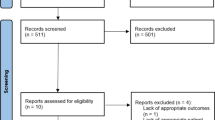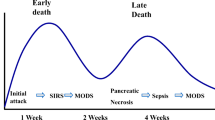Abstract
Introduction
Acute biliary pancreatitis (ABP) is a severe complication of gallstone disease with considerable mortality, and its recurrence rate is reported as 50–90% for ABP patients who do not undergo cholecystectomy. However, the incidence of and risk factors for recurrent pancreatobiliary complications after the initial improvement of ABP are not well established in the literature. The aims of this study were to determine the risk factors for recurrent pancreatobiliary complications and to compare the outcomes between early (within 2 weeks after onset of pancreatitis) and delayed cholecystectomy in patients with ABP.
Methods
Patients diagnosed with ABP at Yeungnam University Hospital from January 2004 to July 2016 were retrospectively reviewed. The following risk factors for recurrent pancreatobiliary complications (acute pancreatitis, acute cholecystitis, and acute cholangitis) were analyzed: demographic characteristics, laboratory data, size and number of gallstones, severity of pancreatitis, endoscopic sphincterotomy, and timing of cholecystectomy. Patients were categorized into two groups: patients with recurrent pancreatobiliary complications (Group A) and patients without pancreatobiliary complications (Group B).
Results
Of the total 290 patients with ABP (age 66.8 ± 16.0 years, male 47.9%), 56 (19.3%) patients developed recurrent pancreatobiliary complications, of which 35 cases were acute pancreatitis, 11 cases were acute cholecystitis, and 10 cases were acute cholangitis. Endoscopic sphincterotomy and cholecystectomy were performed in 134 (46.2%) patients and 95 (32.8%) patients, respectively. Age, sex, BMI, diabetes, number of stone, severity of pancreatitis, and laboratory data were not significantly correlated with recurrent pancreatobiliary complications. The risk of recurrent pancreatobiliary complications was significantly increased in the delayed cholecystectomy group compared with the early cholecystectomy group (45.5 vs. 5.0%, p < 0.001). Based on the multivariate logistic regression analyses, two factors, size of gallstone less than or equal to 5 mm and delayed cholecystectomy, were found as risk factors associated with recurrent pancreatobiliary complications.
Conclusion
The incidence of recurrent pancreatobiliary complications was 19.3% and was significantly increased in patients with size of gallstone less than or equal to 5 mm and in those who underwent delayed cholecystectomy.


Similar content being viewed by others
References
Forsmark CE, Baillie J, AGA Institute Clinical Practice and Economics Committee, AGA Institute Governing Board. AGA Institute technical review on acute pancreatitis. Gastroenterology. 2007;132:2022–2044.
Opie EL, Meakins JC. Data concerning the etiology and pathology of hemorrhagic necrosis of the pancreas (acute hemorrhagic pancreatitis). J Exp Med. 1909;11:561–578.
Corfield AP, Cooper MJ, Williamson RC. Acute pancreatitis: a lethal disease of increasing incidence. Gut. 1985;26:724–729.
Banks PA, Freeman ML. Practice Parameters Committee of the American College of G. Practice guidelines in acute pancreatitis. Am J Gastroenterol. 2006;101:2379–2400.
Kimura Y, Takada T, Kawarada Y, et al. JPN Guidelines for the management of acute pancreatitis: treatment of gallstone-induced acute pancreatitis. J Hepatobiliary Pancreat Surg. 2006;13:56–60.
Cucher D, Kulvatunyou N, Green DJ, Jie T, Ong ES. Gallstone pancreatitis: a review. Surg Clin North Am. 2014;94:257–280.
Kelly TR, Swaney PE. Gallstone pancreatitis: the second time around. Surgery. 1982;92:571–575.
Burstow MJ, Yunus RM, Hossain MB, Khan S, Memon B, Memon MA. Meta-analysis of early endoscopic retrograde cholangiopancreatography (ERCP) ± endoscopic sphincterotomy (ES) versus conservative management for gallstone pancreatitis (GSP). Surg Laparosc Endosc Percutaneous Tech. 2015;25:185–203.
Neoptolemos JP, Carr-Locke DL, London NJ, Bailey IA, James D, Fossard DP. Controlled trial of urgent endoscopic retrograde cholangiopancreatography and endoscopic sphincterotomy versus conservative treatment for acute pancreatitis due to gallstones. Lancet. 1988;2:979–983.
Kaw M, Al-Antably Y, Kaw P. Management of gallstone pancreatitis: cholecystectomy or ERCP and endoscopic sphincterotomy. Gastrointest Endosc. 2002;56:61–65.
Uomo G, Manes G, Laccetti M, Cavallera A, Rabitti PG. Endoscopic sphincterotomy and recurrence of acute pancreatitis in gallstone patients considered unfit for surgery. Pancreas. 1997;14:28–31.
Lee SP, Nicholls JF, Park HZ. Biliary sludge as a cause of acute pancreatitis. N Engl J Med. 1992;326:589–593.
Banks PA, Bollen TL, Dervenis C, et al. Classification of acute pancreatitis—2012: revision of the Atlanta classification and definitions by international consensus. Gut. 2013;62:102–111.
Tenner S, Dubner H, Steinberg W. Predicting gallstone pancreatitis with laboratory parameters: a meta-analysis. Am J Gastroenterol. 1994;89:1863–1866.
Neoptolemos JP, Hall AW, Finlay DF, Berry JM, Carr-Locke DL, Fossard DP. The urgent diagnosis of gallstones in acute pancreatitis: a prospective study of three methods. Br J Surg. 1984;71:230–233.
Working Party of the British Society of Gastroenterology, Association of Surgeons of Great Britain and Ireland, Pancreatic Society of Great Britain and Ireland, Association of Upper GI Surgeons of Great Britain and Ireland. UK guidelines for the management of acute pancreatitis. Gut. 2005;54 Suppl 3:iii1–iii9.
van Baal MC, Besselink MG, Bakker OJ, et al. Timing of cholecystectomy after mild biliary pancreatitis: a systematic review. Ann Surg. 2012;255:860–866.
Gullo L, Migliori M, Pezzilli R, et al. An update on recurrent acute pancreatitis: data from five European countries. Am J Gastroenterol. 2002;97:1959–1962.
Lankisch PG, Bruns A, Doobe C, Weber-Dany B, Maisonneuve P, Lowenfels AB. The second attack of acute pancreatitis is not harmless. Pancreas. 2008;36:207–208.
Paloyan D, Simonowitz D, Skinner DB. The timing of biliary tract operations in patients with pancreatitis associated with gallstones. Surg Gynecol Obstet. 1975;141:737–739.
Nguyen GC, Rosenberg M, Chong RY, Chong CA. Early cholecystectomy and ERCP are associated with reduced readmissions for acute biliary pancreatitis: a nationwide, population-based study. Gastrointest Endosc. 2012;75:47–55.
Tenner S, Baillie J, DeWitt J, Vege SS, American College of Gastroenterology. American College of Gastroenterology guideline: management of acute pancreatitis. Am J Gastroenterol. 2013;108:1400–1415, 1416.
Yokoe M, Takada T, Mayumi T, et al. Japanese guidelines for the management of acute pancreatitis: Japanese Guidelines 2015. J Hepatobiliary Pancreat Sci. 2015;22:405–432.
Working Group IAPAPAAPG. IAP/APA evidence-based guidelines for the management of acute pancreatitis. Pancreatology. 2013;13:e1–e15.
Alimoglu O, Ozkan OV, Sahin M, Akcakaya A, Eryilmaz R, Bas G. Timing of cholecystectomy for acute biliary pancreatitis: outcomes of cholecystectomy on first admission and after recurrent biliary pancreatitis. World J Surg. 2003;27:256–259.
Cameron DR, Goodman AJ. Delayed cholecystectomy for gallstone pancreatitis: re-admissions and outcomes. Ann R Coll Surg Engl. 2004;86:358–362.
Schachter P, Peleg T, Cohen O. Interval laparoscopic cholecystectomy in the management of acute biliary pancreatitis. HPB Surg. 2000;11:319–322. (discussion 322–313).
Davidson BR, Neoptolemos JP, Carr-Locke DL. Endoscopic sphincterotomy for common bile duct calculi in patients with gall bladder in situ considered unfit for surgery. Gut. 1988;29:114–120.
Hill J, Martin DF, Tweedle DE. Risks of leaving the gallbladder in situ after endoscopic sphincterotomy for bile duct stones. Br J Surg. 1991;78:554–557.
Shemesh E, Czerniak A, Schneabaum S, Nass S. Early endoscopic sphincterotomy in the management of acute gallstone pancreatitis in elderly patients. J Am Geriatr Soc. 1990;38:893–896.
van Geenen EJ, van der Peet DL, Mulder CJ, Cuesta MA, Bruno MJ. Recurrent acute biliary pancreatitis: the protective role of cholecystectomy and endoscopic sphincterotomy. Surg Endosc. 2009;23:950–956.
Diehl AK, Holleman DR Jr, Chapman JB, Schwesinger WH, Kurtin WE. Gallstone size and risk of pancreatitis. Arch Intern Med. 1997;157:1674–1678.
McMahon MJ, Shefta JR. Physical characteristics of gallstones and the calibre of the cystic duct in patients with acute pancreatitis. Br J Surg. 1980;67:6–9.
Venneman NG, Buskens E, Besselink MG, et al. Small gallstones are associated with increased risk of acute pancreatitis: potential benefits of prophylactic cholecystectomy? Am J Gastroenterol. 2005;100:2540–2550.
Chebli JM, Duarte Gaburri P, Meirelles de Souza AF, et al. “Idiopathic” acute pancreatitis due to biliary sludge: prevention of relapses by endoscopic biliary sphincterotomy in high-risk patients. Am J Gastroenterol. 2000;95:3008–3009.
Ros E, Navarro S, Bru C, Garcia-Puges A, Valderrama R. Occult microlithiasis in ‘idiopathic’ acute pancreatitis: prevention of relapses by cholecystectomy or ursodeoxycholic acid therapy. Gastroenterology. 1991;101:1701–1709.
Ranson JH. Etiological and prognostic factors in human acute pancreatitis: a review. Am J Gastroenterol. 1982;77:633–638.
Acknowledgments
This work was supported by the 2015 Yeungnam University Research Grant.
Author information
Authors and Affiliations
Corresponding author
Ethics declarations
Conflict of interest
The authors have no potential conflict of interest to declare.
Additional information
Classifications: 20.6: Clinical Acute Pancreatitis; 3.3: Clinical Biliary Stone Diseases and Stone Pathogenesis; 4.4: Outcome Research.
Rights and permissions
About this article
Cite this article
Kim, S.B., Kim, T.N., Chung, H.H. et al. Small Gallstone Size and Delayed Cholecystectomy Increase the Risk of Recurrent Pancreatobiliary Complications After Resolved Acute Biliary Pancreatitis. Dig Dis Sci 62, 777–783 (2017). https://doi.org/10.1007/s10620-016-4428-3
Received:
Accepted:
Published:
Issue Date:
DOI: https://doi.org/10.1007/s10620-016-4428-3




